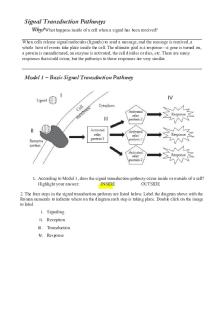Chapter 11 - Signal Transduction Pathways PDF

| Title | Chapter 11 - Signal Transduction Pathways |
|---|---|
| Author | Emily Oliveira |
| Course | Cell Biology |
| Institution | Louisiana State University |
| Pages | 3 |
| File Size | 228.6 KB |
| File Type | |
| Total Downloads | 103 |
| Total Views | 177 |
Summary
Worksheet answers for Transduction Pathway assignment on chapter 12....
Description
Signal Transduction Pathways Why?What happens inside of a cell when a signal has been received? When cells release signal molecules (ligands) to send a message, and the message is received, a whole host of events take place inside the cell. The ultimate goal is a response—a gene is turned on, a protein is manufactured, an enzyme is activated, the cell divides or dies, etc. There are many responses that could occur, but the pathways to those responses are very similar.
Model 1 – Basic Signal Transduction Pathway I
IV
III II
1. According to Model 1, does the signal transduction pathway occur inside or outside of a cell? Highlight your answer: INSIDE OUTSIDE 2. The four steps in the signal transduction pathway are listed below. Label the diagram above with the Roman numerals to indicate where on the diagram each step is taking place. Double click on the image to label I. Signaling II. Reception III. Transduction IV. Response
4. Amplification often occurs during the transduction step in the signal transduction pathway. a. Define “amplification” as it is used in everyday language. making something more, like putting the volume up b. Explain how the signal in Model 1 was amplified. one ligand lead to a big reaction 5. List several possible responses that could occur due to a signal being received by a cell. (Hint: There are several listed in the Why? box.) growth, death, enzyme activation, protein manufacture 6. Once the response is achieved in a cell, what would need to occur to stop the response? The relay proteins would need to be deactivated.
Read This! Signal transduction pathways are as varied as the species on Earth, but each of them follow the same basic steps. Reception may occur by the ligand attaching to a receptor protein or the ligand may travel through the cell membrane by diffusion. Transduction may occur by one protein or by several proteins activating each other in a cascade. Keep this in mind as you continue working through this activity.
Model 2 – Phosphorylation Cascade
7. Refer to Model 2. Describe the event that sets off a phosphorylation cascade inside of a cell. ligand causes receptor protein to activate a relay protein 8. Phosphorylation is a process that adds a phosphate group onto a protein to “activate” it—that is, to change its shape enough that it can function properly. a. Which step(s) in the phosphorylation cascade illustrated in Model 2 include phosphorylation? 4,5,7 b. Where do the phosphate groups come from that are added to the proteins during phosphorylation? ATP 10. Identify the steps in Model 2 that represent reception, transduction, and response for the phosphorylation pathway. Reception (1)
Transduction (2-6)
Response (7)
11. What advantage would there be to an organism if the signal transduction pathway had several amplification steps? a single liquid molecule can lead to an amplified response by the cell....
Similar Free PDFs

Transduction
- 4 Pages

Signal Phrases
- 1 Pages

Acuity and Visual Pathways
- 18 Pages

Pathways BBLR new
- 1 Pages

Sensory Pathways - Google Docs
- 28 Pages

Ch-11 - Chapter 11
- 11 Pages

Digital Signal Processing
- 168 Pages

Sonar Signal Processing
- 14 Pages

matlab signal generations
- 48 Pages

Chapter 11
- 14 Pages

Chapter 11
- 24 Pages

Chapter 11
- 6 Pages

Chapter 11
- 56 Pages

Chapter 11
- 3 Pages
Popular Institutions
- Tinajero National High School - Annex
- Politeknik Caltex Riau
- Yokohama City University
- SGT University
- University of Al-Qadisiyah
- Divine Word College of Vigan
- Techniek College Rotterdam
- Universidade de Santiago
- Universiti Teknologi MARA Cawangan Johor Kampus Pasir Gudang
- Poltekkes Kemenkes Yogyakarta
- Baguio City National High School
- Colegio san marcos
- preparatoria uno
- Centro de Bachillerato Tecnológico Industrial y de Servicios No. 107
- Dalian Maritime University
- Quang Trung Secondary School
- Colegio Tecnológico en Informática
- Corporación Regional de Educación Superior
- Grupo CEDVA
- Dar Al Uloom University
- Centro de Estudios Preuniversitarios de la Universidad Nacional de Ingeniería
- 上智大学
- Aakash International School, Nuna Majara
- San Felipe Neri Catholic School
- Kang Chiao International School - New Taipei City
- Misamis Occidental National High School
- Institución Educativa Escuela Normal Juan Ladrilleros
- Kolehiyo ng Pantukan
- Batanes State College
- Instituto Continental
- Sekolah Menengah Kejuruan Kesehatan Kaltara (Tarakan)
- Colegio de La Inmaculada Concepcion - Cebu

